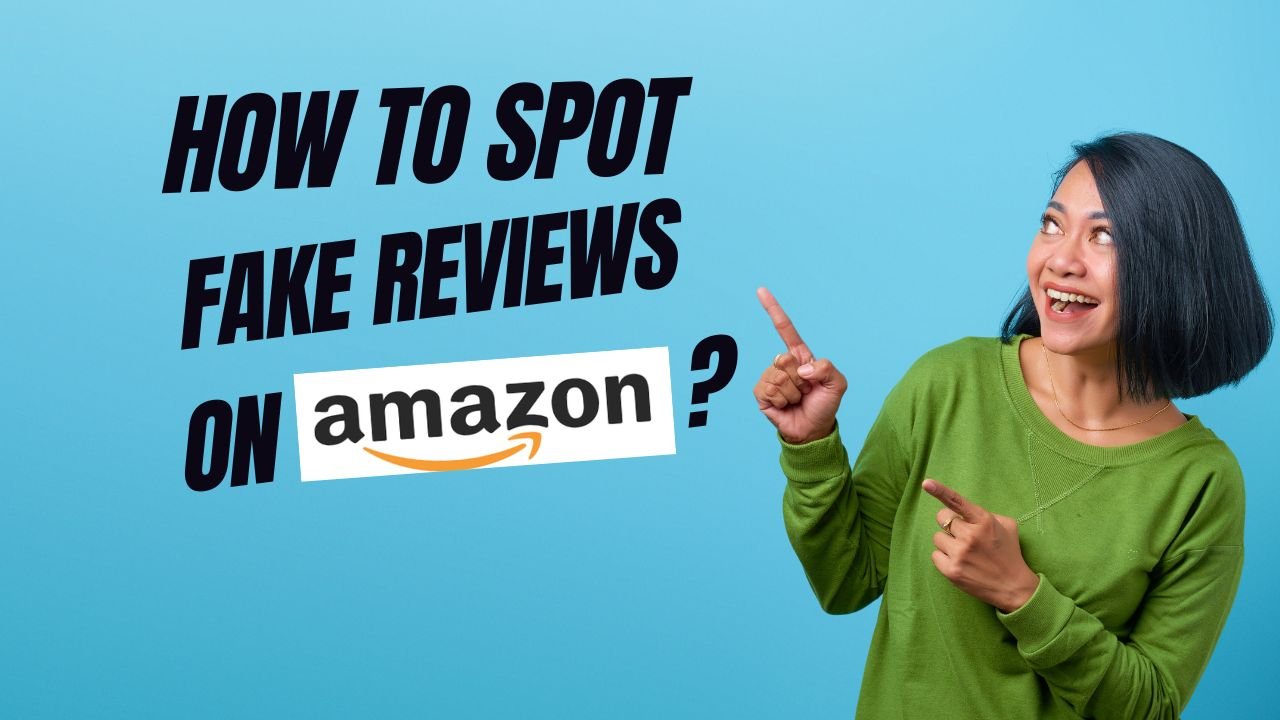How to Spot Fake Reviews on Amazon? Ever found yourself questioning the authenticity of a glowing review on Amazon? You’re not alone. With the rise of online shopping, fake reviews have become a significant issue, misleading countless shoppers. Verified reviews are crucial for making informed purchasing decisions, but spotting fake ones can be tricky. In this post, we’ll uncover the telltale signs of fake reviews on Amazon, helping you shop smarter and trust your choices. Let’s dive into the world of online reviews and ensure your next purchase is based on genuine feedback.
Understanding Fake Reviews
Fake reviews can turn your shopping experience upside down, making you skeptical about even the most genuine feedback. Knowing what fake reviews are and how frequently they appear on Amazon is crucial. Here’s how to get ahead of the game and avoid falling for misleading opinions.
What is a Fake Review?
A fake review is fabricated customer feedback meant to deceive potential buyers. These reviews can be overly positive or negative and often are used to either promote a product falsely or discredit it unjustly. Sometimes, these reviews are the result of paid activities, where individuals are hired to write reviews without even using the product. As a savvy shopper, your ability to spot these reviews is essential.
Prevalence of Fake Reviews on Amazon
Fake reviews aren’t just a few isolated incidents. They are surprisingly common. According to recent studies, around 44% of Amazon reviews can be misleading. This means nearly half of the feedback you read could be false. Also, about one in five ratings are given in exchange for a product discount, which again raises questions about their authenticity.
Why Are Fake Reviews a Problem?
Fake reviews skew the perception of product quality. Here’s why they’re problematic:
- Mislead Buyers: Fake glowing reviews can push you to buy a low-quality product.
- Unfair Competition: Genuine sellers might get undermined due to competitors posting fake negative reviews.
- Violate Trust: Repeated encounters with fake reviews can make customers distrustful of the entire review system.
Tools Amazon Uses to Combat Fake Reviews
Amazon is continuously working to tackle fake reviews to ensure a trustworthy shopping experience. They use artificial intelligence to analyze reviews before they’re published. The AI checks for several indicators that might suggest a review isn’t genuine. Although this is a step in the right direction, it’s not foolproof. Hence, our responsibility as shoppers to identify fake reviews remains vital.
By understanding what fake reviews are and how common they are on Amazon, you can stay alert and make better purchasing decisions. Up next, we’ll provide tips on how to spot these fake reviews yourself.
Signs of Fake Reviews on Amazon
As an Amazon shopper, understanding how to spot fake reviews can save you a lot of frustration and money. These reviews can be deceptively persuasive, but knowing what to look for can make all the difference. Let’s start with some key signs of fake reviews on Amazon.
Overly Positive or Negative Language
One of the most common signs of fake reviews is the use of overly positive or negative language. Genuine reviews usually have balanced views, highlighting both pros and cons. On the other hand, fake reviews tend to be exaggerated.
Watch out for:
- Excessive Praise: Words like “amazing,” “perfect,” or “best” might be red flags if they are not backed by tangible details.
- Harsh Criticism: The complete opposite, where products are negatively bashed using extreme words like “worst,” “terrible,” or “never buy,” especially without concrete reasons.
For instance, if a reviewer says a product “changed their life” but doesn’t explain how to be cautious. These hyperbolic statements often signal a dishonest review.
Reviewer Profile Analysis
A simple yet effective way to spot fake reviews is by analyzing the reviewer’s profile. Authentic reviewers usually have a detailed history that shows a pattern of varied and credible activity over time.
Key points to check:
- Review History: Look at how many reviews they’ve written and over what period. Real profiles will have reviews spread out over the years and for different items.
- Reviewer Details: Limited information or a vague profile could signal a fake account. Genuine profiles typically have a display photo and more personal information.
One way to dive into a profile is to check if they often review similar products within a short timeframe. For more in-depth tips on examining profiles, you can visit this insightful guide.
High Volume of Reviews in Short Period
A sudden influx of reviews can also indicate manipulation. If a product suddenly receives a large number of reviews within a short period, it could be a sign that the seller has recruited people to write fake reviews.
Things to look for:
- Time Stamps: Check the dates of the reviews. A lot of five-star reviews posted close together can be suspicious.
- Pattern of Similarity: If many reviews are not only clustered in time but also contain similar phrases or writing styles, they might be fake.
Genuine purchasers tend to leave reviews sporadically over time. This trend is a clear indicator of manipulation. For more details on how to identify such patterns, consider following up on credible resources like Consumer Reports.
Understanding these signs can significantly improve your ability to spot fake reviews on Amazon. Up next, we’ll discuss the tools and techniques you can use to further validate the authenticity of Amazon reviews.
Tools to Identify Fake Reviews
Spotting fake reviews on Amazon can be quite tricky. Thankfully, several tools are designed specifically to help you separate genuine feedback from dishonest ones. These tools can significantly enhance your shopping experience.
Fakespot: How It Works and Its Reliability
Fakespot is a popular tool that analyzes reviews on eCommerce platforms, including Amazon, to assess their authenticity. Here’s how it operates:
- Algorithm Analysis: Fakespot uses advanced artificial intelligence to scan millions of reviews. The algorithm evaluates various factors, such as the writing style, reviewer profile, and review history, to detect patterns often associated with fake reviews.
- Grade System: After analyzing, Fakespot assigns each product a grade from A to F. This grade reflects the percentage of trustworthy reviews.
- Browser Extensions: Fakespot offers extensions for web browsers like Chrome and Firefox, allowing you to check reviews directly on the Amazon page without switching tabs. Download Fakespot here.
Reliability: Fakespot has proven to be a reliable tool for many shoppers. Positive reviews on its efficacy can be seen across various forums. However, it’s important to use it as one piece of your vetting process since no tool is flawless. There have been discussions about its accuracy, with some people expressing concerns over its algorithms producing false positives. Here is an insightful thread that discusses these limitations.
ReviewMeta: Features and Benefits
Another powerful tool for spotting fake reviews on Amazon is ReviewMeta. Like Fakespot, ReviewMeta helps you identify suspicious reviews and make better buying decisions.
- Review Filtering: ReviewMeta analyzes the published reviews, filtering out those that seem suspicious or unreliable. Once filtered, it provides an adjusted rating based on the credible reviews left.
- Transparency and Detailed Reports: ReviewMeta prides itself on its transparent analysis. You can see detailed reports of why certain reviews were flagged as suspicious. This breakdown includes data like reviewer patterns and linguistic analysis.
- No Account Needed: Unlike some tools that might require you to sign up or download an extension, you can simply copy-paste an Amazon product link into ReviewMeta for an instant report.
Advantages of Using ReviewMeta:
- Accurate Adjustments: By providing an adjusted rating after filtering out unreliable reviews, ReviewMeta offers a clearer picture of the product’s quality.
- User-Friendly: It’s easy to use, whether you’re technically inclined or not. Just one additional step can save you from purchasing a poorly reviewed product.
For more extensive comparisons and to see how it beats others in specific ways, read this comparison here.
By using Fakespot and ReviewMeta, you can significantly reduce the risk of being deceived by fake reviews. These tools, when used in conjunction with your analytical skills, can turn you into a smart shopper who easily spots fake reviews on Amazon. Up next, we’ll look into more methods for identifying fake reviews yourself.
How Amazon Fights Fake Reviews
Amazon is deeply committed to ensuring its reviews are genuine and reliable. By leveraging cutting-edge technologies and implementing stringent policies, Amazon continuously seeks to combat the rampant issue of fake reviews. In this section, we’ll explore how Amazon uses AI and machine learning and the importance of the Verified Purchase badge in this fight.
AI and Machine Learning
Amazon uses advanced AI and machine learning algorithms to identify and remove fake reviews. These technologies play a crucial role in maintaining the credibility of customer feedback.
Here’s how they do it:
- Pattern Recognition: The algorithms scan for patterns typically associated with fake reviews. This includes unusual activity like a sudden surge in positive feedback or similarity in review content.
- Behavior Analysis: AI examines the behavior of reviewers. For instance, if a reviewer is frequently posting five-star reviews within a short period, without detailed comments, it raises a red flag.
- Natural Language Processing (NLP): NLP helps the system understand the context of reviews and detect artificial language that doesn’t sound genuine.
These tools help Amazon’s team swiftly identify suspicious reviews before they can influence purchasing decisions. You can read more about Amazon’s efforts here.
Verified Purchase Badge
The Verified Purchase badge is another powerful tool used by Amazon to ensure the authenticity of reviews.
- What It Is: This badge indicates that the reviewer bought the item from Amazon. It’s tagged onto reviews left by users who purchased the product, helping to confirm their first-hand experience.
- Why It Matters: The badge helps shoppers distinguish between legitimate reviews and those that might be incentivized or fake. Reviews without this badge can sometimes come from individuals who have not used the product.
The Verified Purchase badge provides a layer of trust and transparency, ensuring that the feedback is authentic and based on actual user experience. The presence of the badge can be a quick visual cue for shoppers to rely on the opinions of fellow buyers who have genuinely interacted with the product. Find more details on the badge’s significance here.
By combining AI, machine learning, and the Verified Purchase badge, Amazon continues to build a more reliable and trustworthy review system. These efforts showcase Amazon’s dedication to creating a safe shopping environment and maintaining the integrity of its review platform.
Steps to Take if You Spot a Fake Review
Encountering fake reviews on Amazon can be frustrating, but don’t worry, there are steps you can take to address this issue. Here’s what you can do to maintain the integrity of the reviews and help other consumers make informed decisions.
Reporting to Amazon
If you believe you’ve spotted a fake review, the first step is to report it to Amazon. Amazon takes these reports seriously and investigates them to maintain the authenticity of the reviews on its platform.
Follow these simple steps to report a fake review:
- Identify the Review: Navigate to the review you suspect is fake.
- Click “Report Abuse”: You’ll find this option right next to the review. Clicking it will open a form.
- Fill Out the Form: Provide details on why you believe the review is fake. Mention aspects like unusual language, sudden influx of reviews, or a suspiciously incomplete reviewer profile.
- Submit the Report: After detailing your concerns, submit the form. Amazon’s team will then investigate the review’s authenticity.
By reporting fake reviews, you’re not just helping yourself but also contributing to a fairer market for everyone.
Leaving Helpful Feedback
Apart from reporting, leaving your honest feedback on products you purchase can significantly help the Amazon community. Here’s what you can do:
- Be Honest and Detailed: Write reviews that reflect your true experience with the product. Mention specific features, pros, cons, and whether it met your expectations.
- Provide Photos or Videos: Visual evidence supports your written review, making it more believable and useful to other shoppers.
- Rate Other Reviews: If you find certain reviews helpful or unhelpful, use the “Helpful” and “Not Helpful” buttons. This feedback helps surface the most genuine reviews to the top.
Remember, your honest review could be the deciding factor for someone else considering a purchase, essentially acting as a guide through the potentially murky waters of online shopping.
Taking these steps not only curbs the spread of fake reviews but also contributes to a more trustworthy and reliable review system on Amazon. Your actions can significantly impact the shopping experience for many others, fostering a more genuine community.
The Impact of Fake Reviews on Sellers
Fake reviews on Amazon don’t just affect buyers. They greatly impact sellers too. While some might think the issue only lies with misleading positives that scam the customers, the situation is far more complex. Let’s explore two significant ways fake reviews impact Amazon sellers.
Negative Impact on Genuine Sellers
Imagine spending months or even years building a reputation for your brand. You’ve amassed a loyal customer base and your products are highly rated. Then, out of nowhere, a wave of negative reviews hits your listings.
Fake negative reviews can damage genuine sellers in many ways:
- Reputation Damage: A few poorly rated reviews can greatly affect your overall rating. Consumers often judge based on the overall star rating, and even a small decrease can lead to a loss of trust.
- Reduced Sales: Negative reviews tend to reduce conversion rates. If prospective buyers see numerous negative comments, they are less likely to purchase your product. This can lead to a significant decrease in sales.
- Algorithm Penalties: Amazon’s algorithm considers review quality and quantity. Negative reviews can push your product lower in Amazon search results, decreasing visibility and leading to even fewer sales.
Negative fake reviews are not always easy to recognize and mitigate. They can slip through Amazon’s safeguards and create long-lasting damage to a seller’s reputation and bottom line. According to a discussion in Amazon’s seller forums, many sellers have raised concerns about the significant damage caused by fake negative reviews.
Unfair Advantage for Competitors
Ethical business practices should form the cornerstone of any reputable company. However, in the hyper-competitive environment that is Amazon, some unscrupulous competitors resort to unethical tactics to outperform others.
Here’s how competitors gain unfair advantages through fake reviews:
- Boosting Their Products: Some sellers create fake positive reviews for their products to artificially boost their ratings. This misleads consumers into thinking their product is superior.
- Sabotaging Others: Fake negative reviews are also used to sabotage competitors. By casting doubt on the quality of a rival’s product, they can indirectly drive traffic and sales to their listings.
- Manipulating Rankings: With numerous fake positive reviews, a seller’s product can climb higher in Amazon’s search rankings, leading to better visibility and more sales. Over time, this can marginalize genuine sellers who rely on honest reviews and quality products.
For illustrative purposes, this paper from the Berkeley Haas School of Business dives deep into how fake reviews create inequalities in online marketplaces, showing that manipulated ratings can drastically change consumer behavior and market dynamics.
The blatant manipulation of reviews not only disrupts the market equilibrium but also reflects poorly on the entire platform — eroding trust among all users. For sellers, this means they need to be extra vigilant and proactive in managing their reviews and reporting any suspicious activity to Amazon.
Ultimately, the fight against fake reviews is continuous. Every seller should be aware of the potential impacts and stay equipped with tools and knowledge to combat these unfair practices.
Tips for Writing Authentic Reviews
Writing authentic and helpful reviews is not just beneficial for the community but also crucial for building trust among online shoppers. By sharing your honest experiences, you can help others make informed decisions.
Being Honest and Detailed
When it comes to writing an authentic review, honesty is key. Provide a truthful account of your experience with the product, whether positive or negative. People appreciate transparent feedback, as it helps them form realistic expectations.
Here are some tips to ensure your review is detailed and useful:
- Cover Key Aspects: Discuss various elements such as the quality, usability, performance, and any features that stood out to you.
- Use Your Own Words: Avoid copying phrases from the product description. Your unique voice adds credibility to the review.
- Explain Why: If you mentioned something you liked or disliked, explain why. For example, “The battery lasts long” is better understood with, “The battery lasts long. I used it for eight hours straight while traveling without needing a recharge.”
- Include Photos or Videos: Visual proofs such as images or videos can substantiate your words and give readers a better understanding.
For more ideas on writing reviews, check out this article from Lifehacker.
Avoiding Conflicts of Interest
Keeping reviews free from biases is crucial for maintaining their trustworthiness. When you have a conflict of interest, it can color your perception, intentionally or unintentionally.
Make sure to:
- Disclose Free Products: If you received the product for free or at a discount in exchange for a review, mention it. Transparency strengthens the credibility of your review.
- Stay Impartial: Avoid reviewing products from friends or family, as personal relationships can cloud your judgment.
- Check Your Motives: Only write reviews based on your genuine experience and feelings. If you feel obligated due to any external factors, it’s better to refrain from reviewing.
Engaging in honest and transparent reviewing practices not only helps fellow consumers but also builds a trustworthy review ecosystem. For additional guidelines on keeping your reviews unbiased, take a look at Trustpilot’s review tips.
By being honest, and detailed, and avoiding conflicts of interest, you contribute valuable content that genuinely assists other shoppers. Your reviews become a beacon of trust in the vast sea of online shopping.
Read More: 10 Lesser-Known iPhone Shortcuts You Should Be Using in 2024
How to Spot Fake Reviews on Amazon
Genuine reviews are essential for making well-informed purchasing decisions. By learning to spot fake reviews on Amazon, you safeguard yourself against biased or deceptive feedback. Look for overly positive or negative language, review patterns, and analyze reviewer profiles. Utilize tools like Fakespot and ReviewMeta to validate legitimacy.
Stay vigilant and proactive. Your attentiveness ensures better shopping experiences and supports a more transparent review ecosystem. Trust your instincts and the insights shared here for smarter online shopping.










